Project Purple: Leadership Analysis of iPhone Development Project
VerifiedAdded on 2020/03/16
|13
|2964
|103
Report
AI Summary
This report provides a comprehensive analysis of the leadership challenges and strategies employed during Apple's Project Purple, which culminated in the creation of the first-generation iPhone. The project faced significant hurdles, including poor coordination, inadequate risk management, resource limitations, undefined goals, and a lack of skilled personnel. The report details how these challenges were addressed through hiring skilled individuals, parallel tasking, securing financial backing from Cingular, and fostering better coordination among development teams. Key performance indicators (KPIs) such as timeline, cycle time, on-time completion, and budget variance are examined to gauge project success. Stakeholder management, including interactions with AT&T, Cingular, and Apple's internal staff and customers, is also a central focus. The report further explores the leadership styles, particularly the charismatic leadership of Steve Jobs, and how these styles influenced the project's trajectory. The analysis highlights the importance of effective leadership in navigating complex development projects and achieving successful outcomes, as demonstrated by Apple's journey in bringing the iPhone to market.
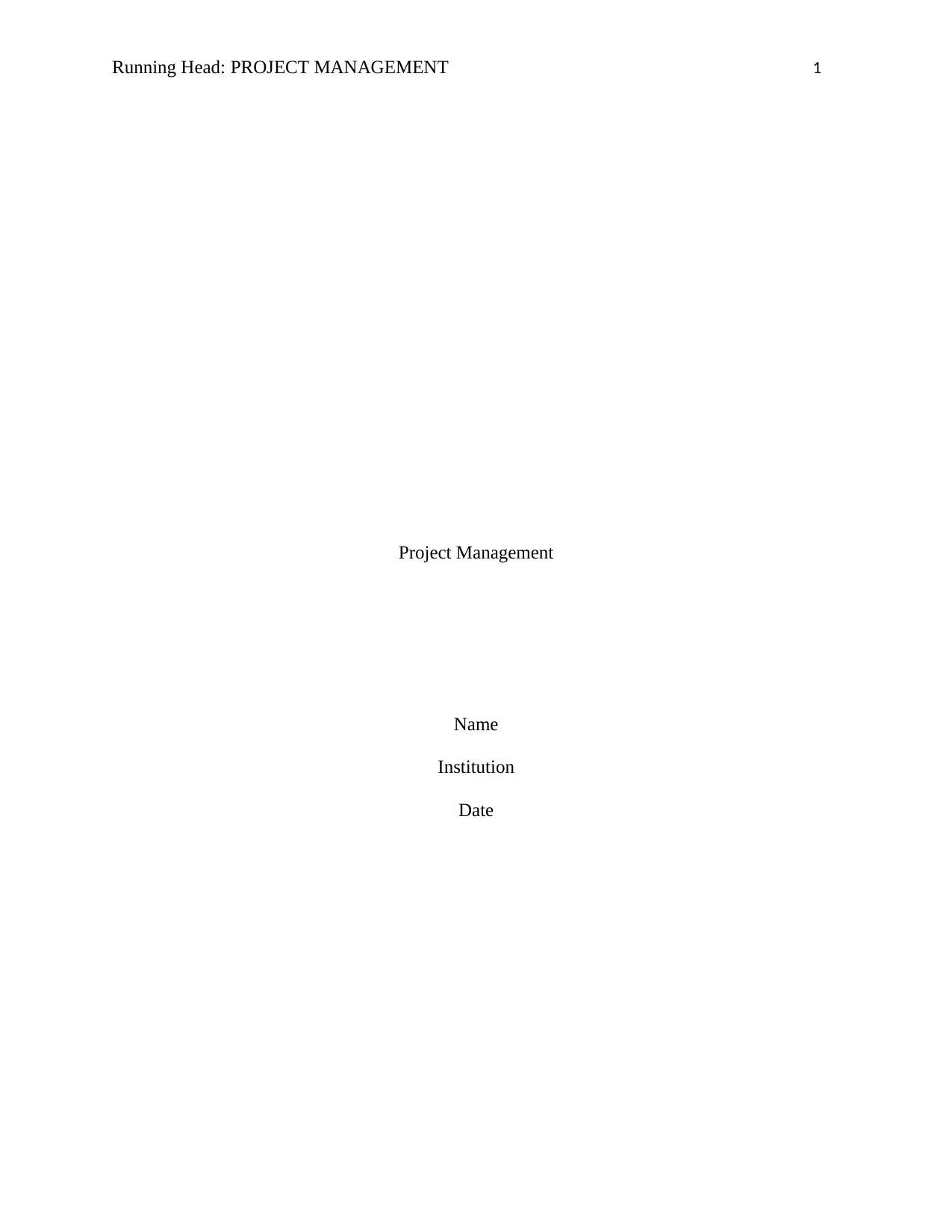
Running Head: PROJECT MANAGEMENT 1
Project Management
Name
Institution
Date
Project Management
Name
Institution
Date
Paraphrase This Document
Need a fresh take? Get an instant paraphrase of this document with our AI Paraphraser
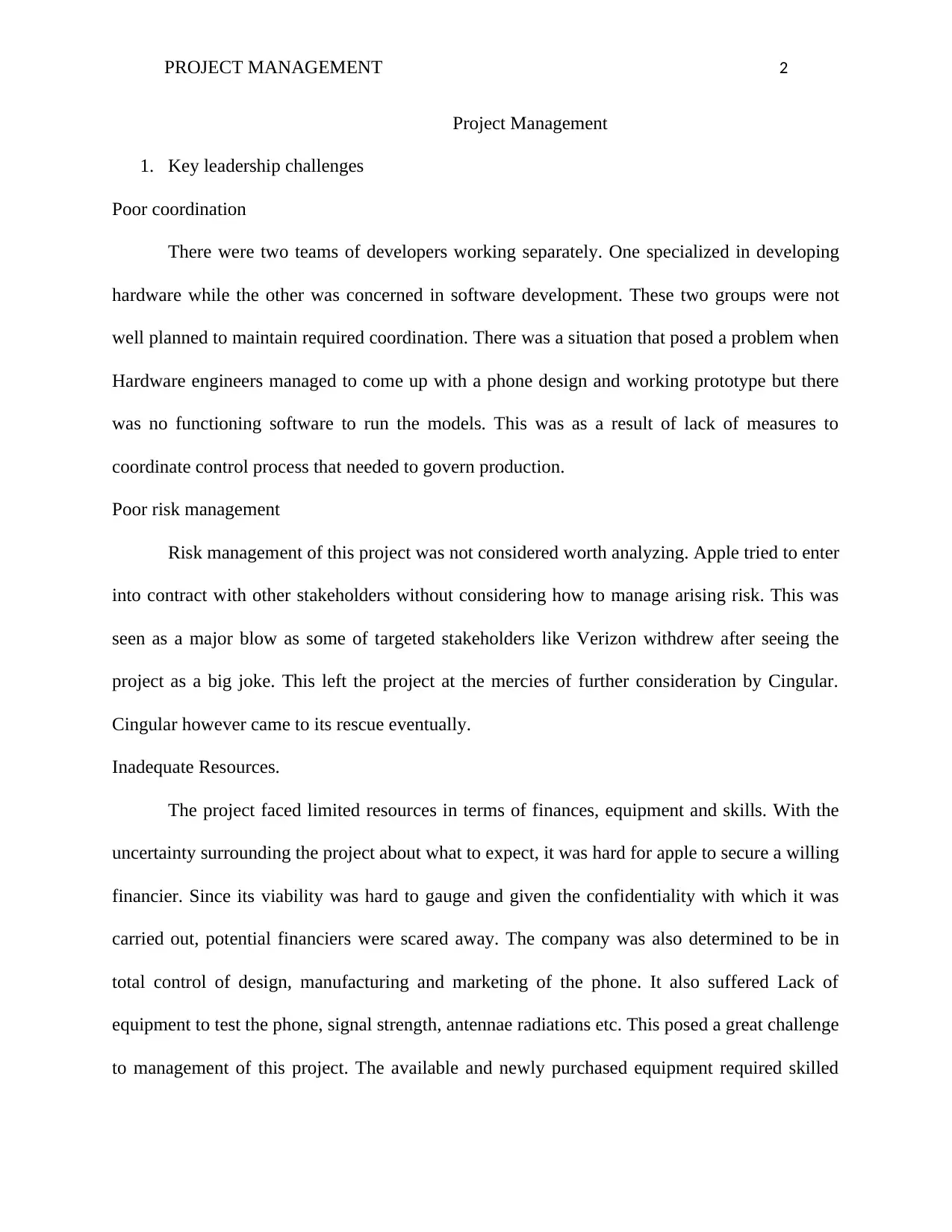
PROJECT MANAGEMENT 2
Project Management
1. Key leadership challenges
Poor coordination
There were two teams of developers working separately. One specialized in developing
hardware while the other was concerned in software development. These two groups were not
well planned to maintain required coordination. There was a situation that posed a problem when
Hardware engineers managed to come up with a phone design and working prototype but there
was no functioning software to run the models. This was as a result of lack of measures to
coordinate control process that needed to govern production.
Poor risk management
Risk management of this project was not considered worth analyzing. Apple tried to enter
into contract with other stakeholders without considering how to manage arising risk. This was
seen as a major blow as some of targeted stakeholders like Verizon withdrew after seeing the
project as a big joke. This left the project at the mercies of further consideration by Cingular.
Cingular however came to its rescue eventually.
Inadequate Resources.
The project faced limited resources in terms of finances, equipment and skills. With the
uncertainty surrounding the project about what to expect, it was hard for apple to secure a willing
financier. Since its viability was hard to gauge and given the confidentiality with which it was
carried out, potential financiers were scared away. The company was also determined to be in
total control of design, manufacturing and marketing of the phone. It also suffered Lack of
equipment to test the phone, signal strength, antennae radiations etc. This posed a great challenge
to management of this project. The available and newly purchased equipment required skilled
Project Management
1. Key leadership challenges
Poor coordination
There were two teams of developers working separately. One specialized in developing
hardware while the other was concerned in software development. These two groups were not
well planned to maintain required coordination. There was a situation that posed a problem when
Hardware engineers managed to come up with a phone design and working prototype but there
was no functioning software to run the models. This was as a result of lack of measures to
coordinate control process that needed to govern production.
Poor risk management
Risk management of this project was not considered worth analyzing. Apple tried to enter
into contract with other stakeholders without considering how to manage arising risk. This was
seen as a major blow as some of targeted stakeholders like Verizon withdrew after seeing the
project as a big joke. This left the project at the mercies of further consideration by Cingular.
Cingular however came to its rescue eventually.
Inadequate Resources.
The project faced limited resources in terms of finances, equipment and skills. With the
uncertainty surrounding the project about what to expect, it was hard for apple to secure a willing
financier. Since its viability was hard to gauge and given the confidentiality with which it was
carried out, potential financiers were scared away. The company was also determined to be in
total control of design, manufacturing and marketing of the phone. It also suffered Lack of
equipment to test the phone, signal strength, antennae radiations etc. This posed a great challenge
to management of this project. The available and newly purchased equipment required skilled
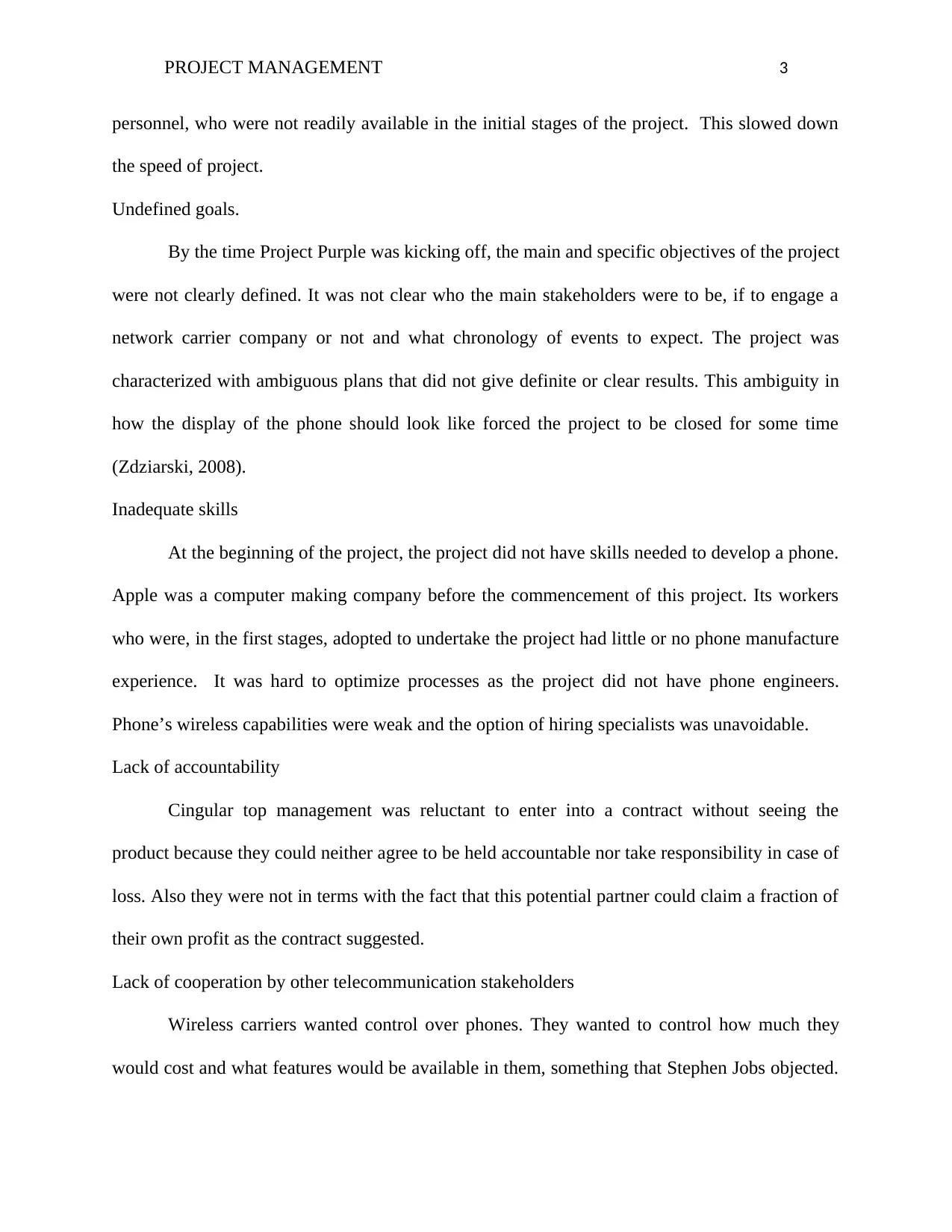
PROJECT MANAGEMENT 3
personnel, who were not readily available in the initial stages of the project. This slowed down
the speed of project.
Undefined goals.
By the time Project Purple was kicking off, the main and specific objectives of the project
were not clearly defined. It was not clear who the main stakeholders were to be, if to engage a
network carrier company or not and what chronology of events to expect. The project was
characterized with ambiguous plans that did not give definite or clear results. This ambiguity in
how the display of the phone should look like forced the project to be closed for some time
(Zdziarski, 2008).
Inadequate skills
At the beginning of the project, the project did not have skills needed to develop a phone.
Apple was a computer making company before the commencement of this project. Its workers
who were, in the first stages, adopted to undertake the project had little or no phone manufacture
experience. It was hard to optimize processes as the project did not have phone engineers.
Phone’s wireless capabilities were weak and the option of hiring specialists was unavoidable.
Lack of accountability
Cingular top management was reluctant to enter into a contract without seeing the
product because they could neither agree to be held accountable nor take responsibility in case of
loss. Also they were not in terms with the fact that this potential partner could claim a fraction of
their own profit as the contract suggested.
Lack of cooperation by other telecommunication stakeholders
Wireless carriers wanted control over phones. They wanted to control how much they
would cost and what features would be available in them, something that Stephen Jobs objected.
personnel, who were not readily available in the initial stages of the project. This slowed down
the speed of project.
Undefined goals.
By the time Project Purple was kicking off, the main and specific objectives of the project
were not clearly defined. It was not clear who the main stakeholders were to be, if to engage a
network carrier company or not and what chronology of events to expect. The project was
characterized with ambiguous plans that did not give definite or clear results. This ambiguity in
how the display of the phone should look like forced the project to be closed for some time
(Zdziarski, 2008).
Inadequate skills
At the beginning of the project, the project did not have skills needed to develop a phone.
Apple was a computer making company before the commencement of this project. Its workers
who were, in the first stages, adopted to undertake the project had little or no phone manufacture
experience. It was hard to optimize processes as the project did not have phone engineers.
Phone’s wireless capabilities were weak and the option of hiring specialists was unavoidable.
Lack of accountability
Cingular top management was reluctant to enter into a contract without seeing the
product because they could neither agree to be held accountable nor take responsibility in case of
loss. Also they were not in terms with the fact that this potential partner could claim a fraction of
their own profit as the contract suggested.
Lack of cooperation by other telecommunication stakeholders
Wireless carriers wanted control over phones. They wanted to control how much they
would cost and what features would be available in them, something that Stephen Jobs objected.
⊘ This is a preview!⊘
Do you want full access?
Subscribe today to unlock all pages.

Trusted by 1+ million students worldwide
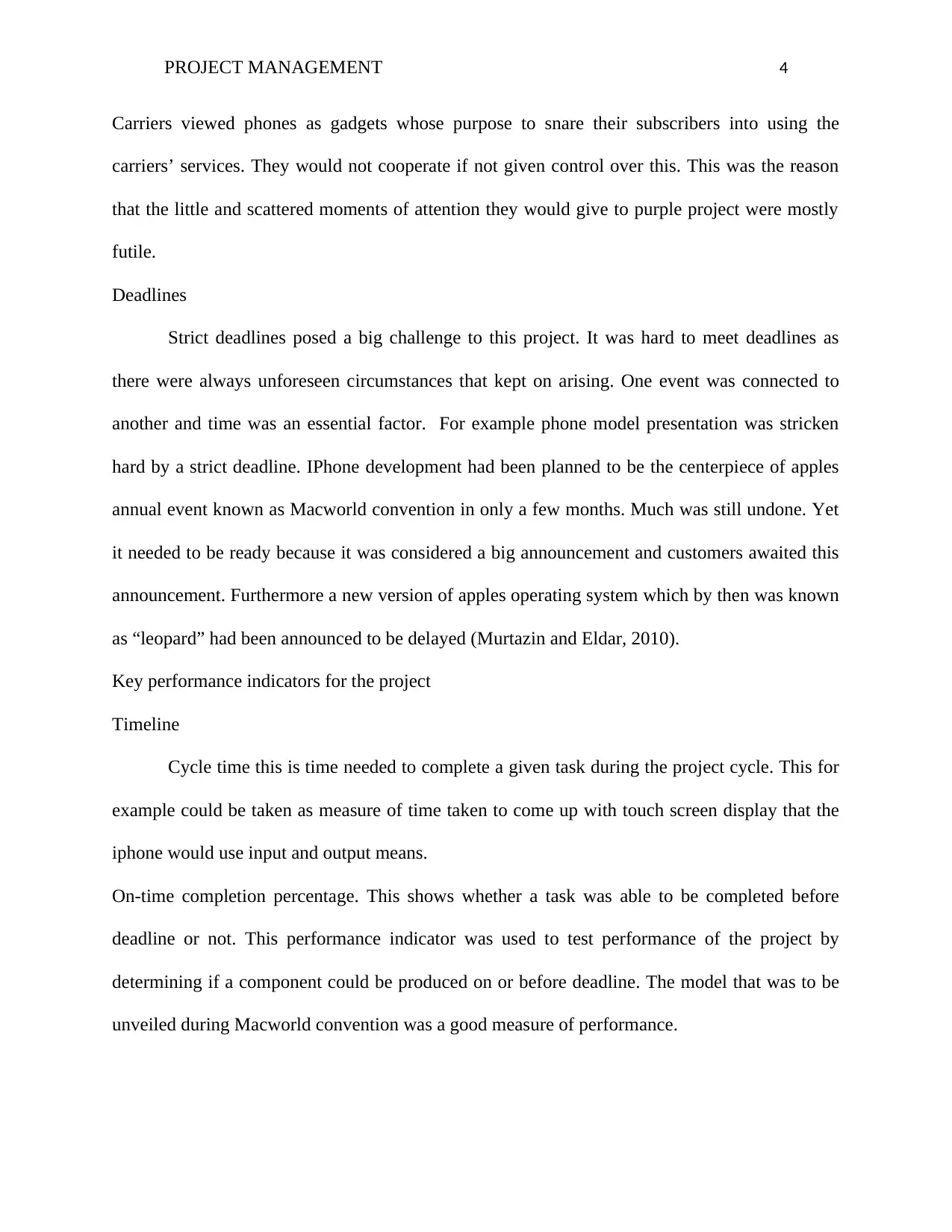
PROJECT MANAGEMENT 4
Carriers viewed phones as gadgets whose purpose to snare their subscribers into using the
carriers’ services. They would not cooperate if not given control over this. This was the reason
that the little and scattered moments of attention they would give to purple project were mostly
futile.
Deadlines
Strict deadlines posed a big challenge to this project. It was hard to meet deadlines as
there were always unforeseen circumstances that kept on arising. One event was connected to
another and time was an essential factor. For example phone model presentation was stricken
hard by a strict deadline. IPhone development had been planned to be the centerpiece of apples
annual event known as Macworld convention in only a few months. Much was still undone. Yet
it needed to be ready because it was considered a big announcement and customers awaited this
announcement. Furthermore a new version of apples operating system which by then was known
as “leopard” had been announced to be delayed (Murtazin and Eldar, 2010).
Key performance indicators for the project
Timeline
Cycle time this is time needed to complete a given task during the project cycle. This for
example could be taken as measure of time taken to come up with touch screen display that the
iphone would use input and output means.
On-time completion percentage. This shows whether a task was able to be completed before
deadline or not. This performance indicator was used to test performance of the project by
determining if a component could be produced on or before deadline. The model that was to be
unveiled during Macworld convention was a good measure of performance.
Carriers viewed phones as gadgets whose purpose to snare their subscribers into using the
carriers’ services. They would not cooperate if not given control over this. This was the reason
that the little and scattered moments of attention they would give to purple project were mostly
futile.
Deadlines
Strict deadlines posed a big challenge to this project. It was hard to meet deadlines as
there were always unforeseen circumstances that kept on arising. One event was connected to
another and time was an essential factor. For example phone model presentation was stricken
hard by a strict deadline. IPhone development had been planned to be the centerpiece of apples
annual event known as Macworld convention in only a few months. Much was still undone. Yet
it needed to be ready because it was considered a big announcement and customers awaited this
announcement. Furthermore a new version of apples operating system which by then was known
as “leopard” had been announced to be delayed (Murtazin and Eldar, 2010).
Key performance indicators for the project
Timeline
Cycle time this is time needed to complete a given task during the project cycle. This for
example could be taken as measure of time taken to come up with touch screen display that the
iphone would use input and output means.
On-time completion percentage. This shows whether a task was able to be completed before
deadline or not. This performance indicator was used to test performance of the project by
determining if a component could be produced on or before deadline. The model that was to be
unveiled during Macworld convention was a good measure of performance.
Paraphrase This Document
Need a fresh take? Get an instant paraphrase of this document with our AI Paraphraser
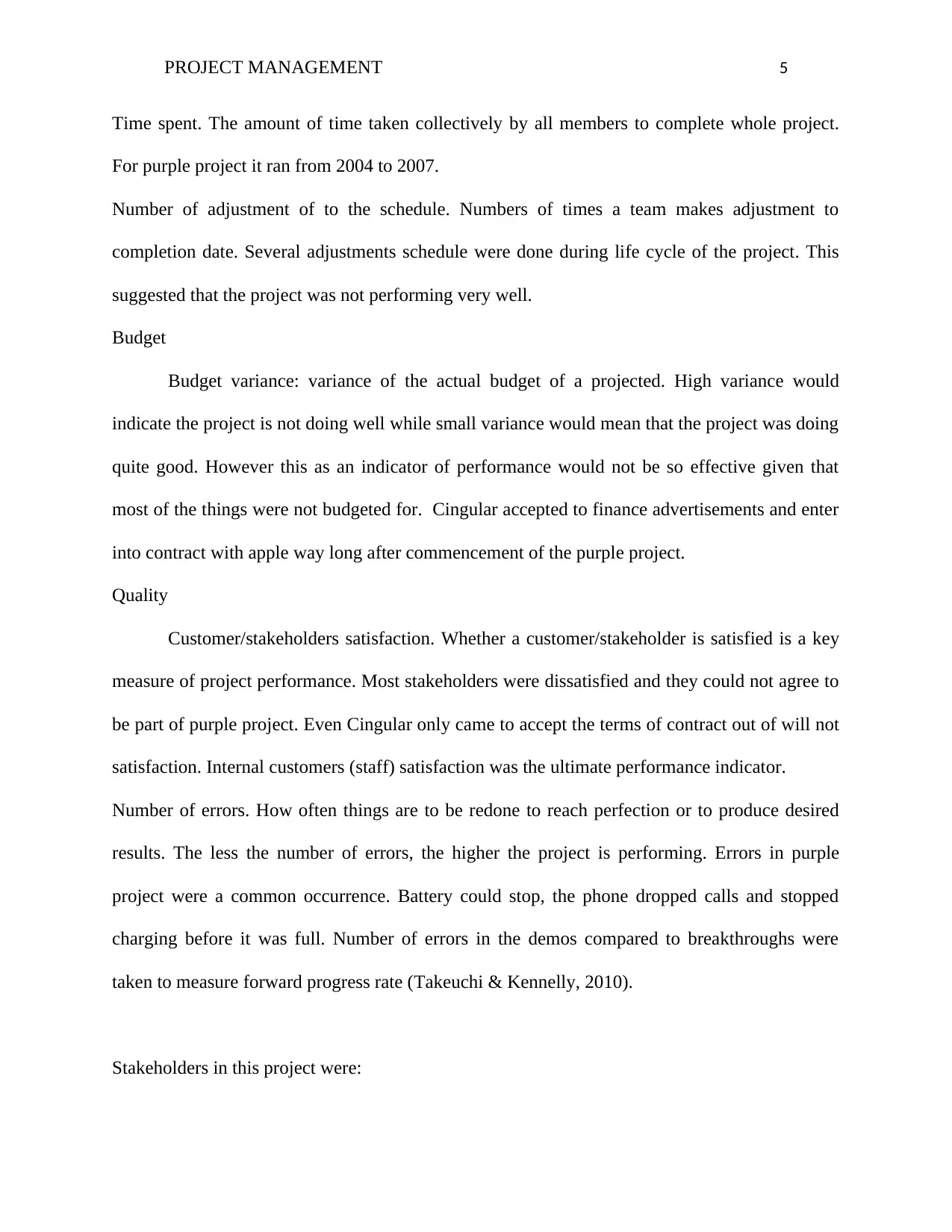
PROJECT MANAGEMENT 5
Time spent. The amount of time taken collectively by all members to complete whole project.
For purple project it ran from 2004 to 2007.
Number of adjustment of to the schedule. Numbers of times a team makes adjustment to
completion date. Several adjustments schedule were done during life cycle of the project. This
suggested that the project was not performing very well.
Budget
Budget variance: variance of the actual budget of a projected. High variance would
indicate the project is not doing well while small variance would mean that the project was doing
quite good. However this as an indicator of performance would not be so effective given that
most of the things were not budgeted for. Cingular accepted to finance advertisements and enter
into contract with apple way long after commencement of the purple project.
Quality
Customer/stakeholders satisfaction. Whether a customer/stakeholder is satisfied is a key
measure of project performance. Most stakeholders were dissatisfied and they could not agree to
be part of purple project. Even Cingular only came to accept the terms of contract out of will not
satisfaction. Internal customers (staff) satisfaction was the ultimate performance indicator.
Number of errors. How often things are to be redone to reach perfection or to produce desired
results. The less the number of errors, the higher the project is performing. Errors in purple
project were a common occurrence. Battery could stop, the phone dropped calls and stopped
charging before it was full. Number of errors in the demos compared to breakthroughs were
taken to measure forward progress rate (Takeuchi & Kennelly, 2010).
Stakeholders in this project were:
Time spent. The amount of time taken collectively by all members to complete whole project.
For purple project it ran from 2004 to 2007.
Number of adjustment of to the schedule. Numbers of times a team makes adjustment to
completion date. Several adjustments schedule were done during life cycle of the project. This
suggested that the project was not performing very well.
Budget
Budget variance: variance of the actual budget of a projected. High variance would
indicate the project is not doing well while small variance would mean that the project was doing
quite good. However this as an indicator of performance would not be so effective given that
most of the things were not budgeted for. Cingular accepted to finance advertisements and enter
into contract with apple way long after commencement of the purple project.
Quality
Customer/stakeholders satisfaction. Whether a customer/stakeholder is satisfied is a key
measure of project performance. Most stakeholders were dissatisfied and they could not agree to
be part of purple project. Even Cingular only came to accept the terms of contract out of will not
satisfaction. Internal customers (staff) satisfaction was the ultimate performance indicator.
Number of errors. How often things are to be redone to reach perfection or to produce desired
results. The less the number of errors, the higher the project is performing. Errors in purple
project were a common occurrence. Battery could stop, the phone dropped calls and stopped
charging before it was full. Number of errors in the demos compared to breakthroughs were
taken to measure forward progress rate (Takeuchi & Kennelly, 2010).
Stakeholders in this project were:
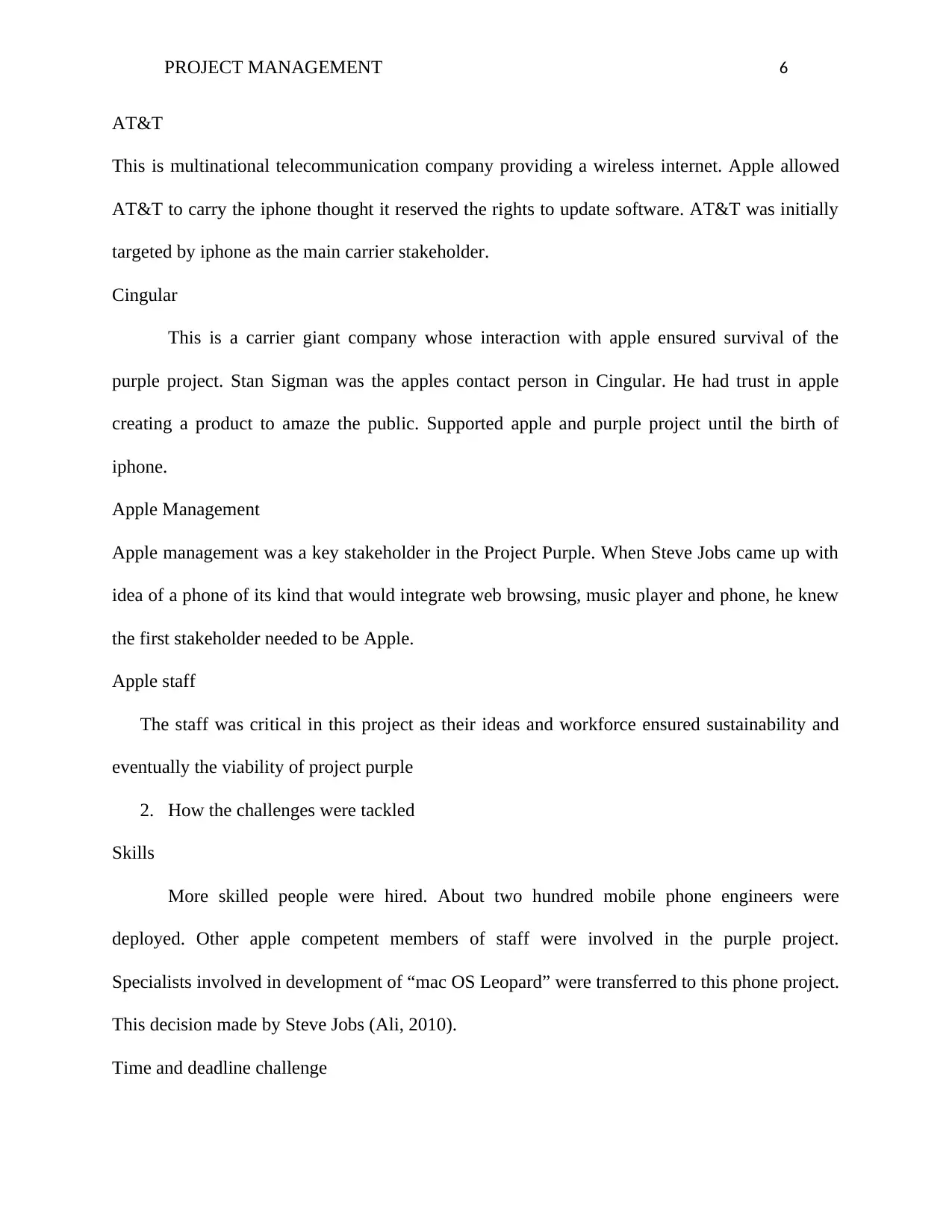
PROJECT MANAGEMENT 6
AT&T
This is multinational telecommunication company providing a wireless internet. Apple allowed
AT&T to carry the iphone thought it reserved the rights to update software. AT&T was initially
targeted by iphone as the main carrier stakeholder.
Cingular
This is a carrier giant company whose interaction with apple ensured survival of the
purple project. Stan Sigman was the apples contact person in Cingular. He had trust in apple
creating a product to amaze the public. Supported apple and purple project until the birth of
iphone.
Apple Management
Apple management was a key stakeholder in the Project Purple. When Steve Jobs came up with
idea of a phone of its kind that would integrate web browsing, music player and phone, he knew
the first stakeholder needed to be Apple.
Apple staff
The staff was critical in this project as their ideas and workforce ensured sustainability and
eventually the viability of project purple
2. How the challenges were tackled
Skills
More skilled people were hired. About two hundred mobile phone engineers were
deployed. Other apple competent members of staff were involved in the purple project.
Specialists involved in development of “mac OS Leopard” were transferred to this phone project.
This decision made by Steve Jobs (Ali, 2010).
Time and deadline challenge
AT&T
This is multinational telecommunication company providing a wireless internet. Apple allowed
AT&T to carry the iphone thought it reserved the rights to update software. AT&T was initially
targeted by iphone as the main carrier stakeholder.
Cingular
This is a carrier giant company whose interaction with apple ensured survival of the
purple project. Stan Sigman was the apples contact person in Cingular. He had trust in apple
creating a product to amaze the public. Supported apple and purple project until the birth of
iphone.
Apple Management
Apple management was a key stakeholder in the Project Purple. When Steve Jobs came up with
idea of a phone of its kind that would integrate web browsing, music player and phone, he knew
the first stakeholder needed to be Apple.
Apple staff
The staff was critical in this project as their ideas and workforce ensured sustainability and
eventually the viability of project purple
2. How the challenges were tackled
Skills
More skilled people were hired. About two hundred mobile phone engineers were
deployed. Other apple competent members of staff were involved in the purple project.
Specialists involved in development of “mac OS Leopard” were transferred to this phone project.
This decision made by Steve Jobs (Ali, 2010).
Time and deadline challenge
⊘ This is a preview!⊘
Do you want full access?
Subscribe today to unlock all pages.

Trusted by 1+ million students worldwide
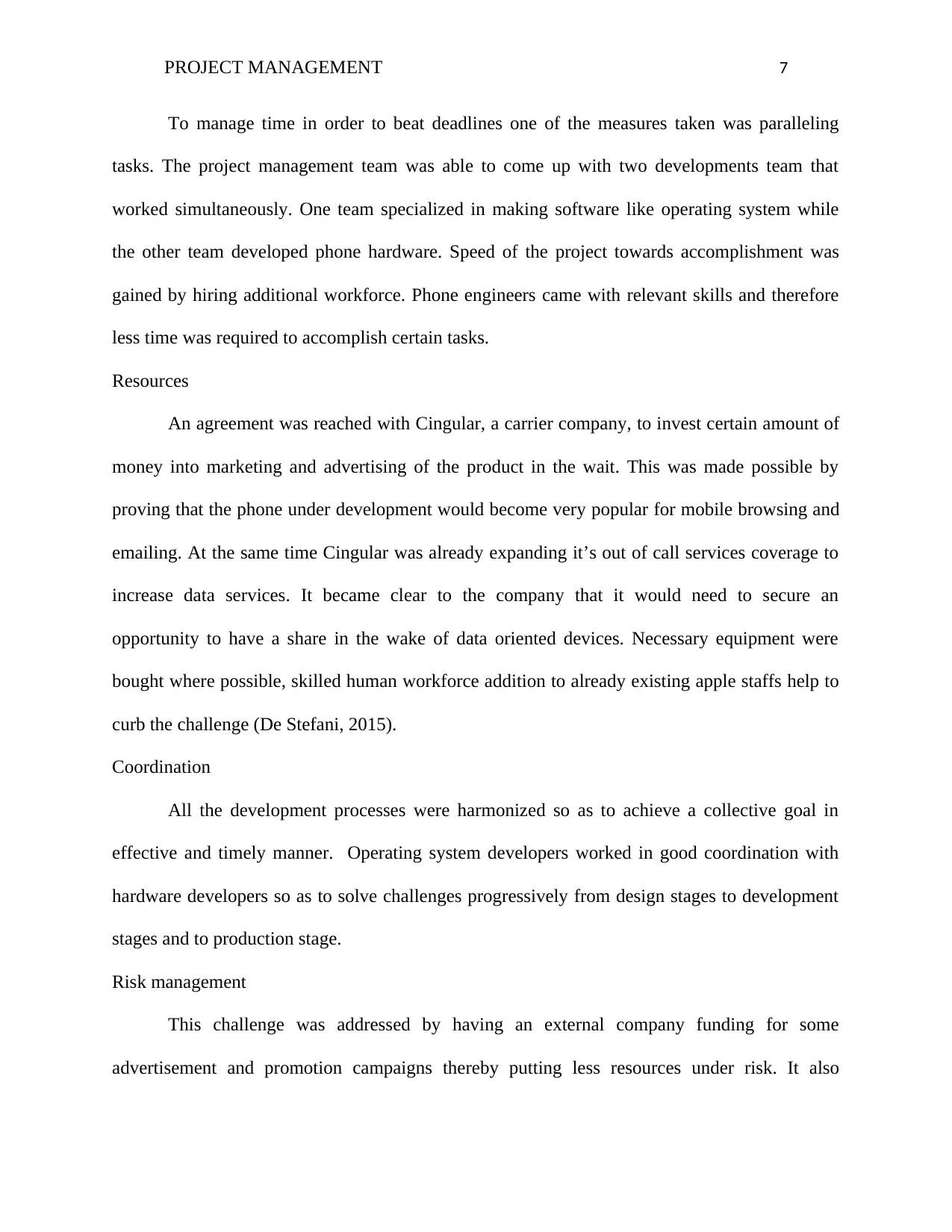
PROJECT MANAGEMENT 7
To manage time in order to beat deadlines one of the measures taken was paralleling
tasks. The project management team was able to come up with two developments team that
worked simultaneously. One team specialized in making software like operating system while
the other team developed phone hardware. Speed of the project towards accomplishment was
gained by hiring additional workforce. Phone engineers came with relevant skills and therefore
less time was required to accomplish certain tasks.
Resources
An agreement was reached with Cingular, a carrier company, to invest certain amount of
money into marketing and advertising of the product in the wait. This was made possible by
proving that the phone under development would become very popular for mobile browsing and
emailing. At the same time Cingular was already expanding it’s out of call services coverage to
increase data services. It became clear to the company that it would need to secure an
opportunity to have a share in the wake of data oriented devices. Necessary equipment were
bought where possible, skilled human workforce addition to already existing apple staffs help to
curb the challenge (De Stefani, 2015).
Coordination
All the development processes were harmonized so as to achieve a collective goal in
effective and timely manner. Operating system developers worked in good coordination with
hardware developers so as to solve challenges progressively from design stages to development
stages and to production stage.
Risk management
This challenge was addressed by having an external company funding for some
advertisement and promotion campaigns thereby putting less resources under risk. It also
To manage time in order to beat deadlines one of the measures taken was paralleling
tasks. The project management team was able to come up with two developments team that
worked simultaneously. One team specialized in making software like operating system while
the other team developed phone hardware. Speed of the project towards accomplishment was
gained by hiring additional workforce. Phone engineers came with relevant skills and therefore
less time was required to accomplish certain tasks.
Resources
An agreement was reached with Cingular, a carrier company, to invest certain amount of
money into marketing and advertising of the product in the wait. This was made possible by
proving that the phone under development would become very popular for mobile browsing and
emailing. At the same time Cingular was already expanding it’s out of call services coverage to
increase data services. It became clear to the company that it would need to secure an
opportunity to have a share in the wake of data oriented devices. Necessary equipment were
bought where possible, skilled human workforce addition to already existing apple staffs help to
curb the challenge (De Stefani, 2015).
Coordination
All the development processes were harmonized so as to achieve a collective goal in
effective and timely manner. Operating system developers worked in good coordination with
hardware developers so as to solve challenges progressively from design stages to development
stages and to production stage.
Risk management
This challenge was addressed by having an external company funding for some
advertisement and promotion campaigns thereby putting less resources under risk. It also
Paraphrase This Document
Need a fresh take? Get an instant paraphrase of this document with our AI Paraphraser
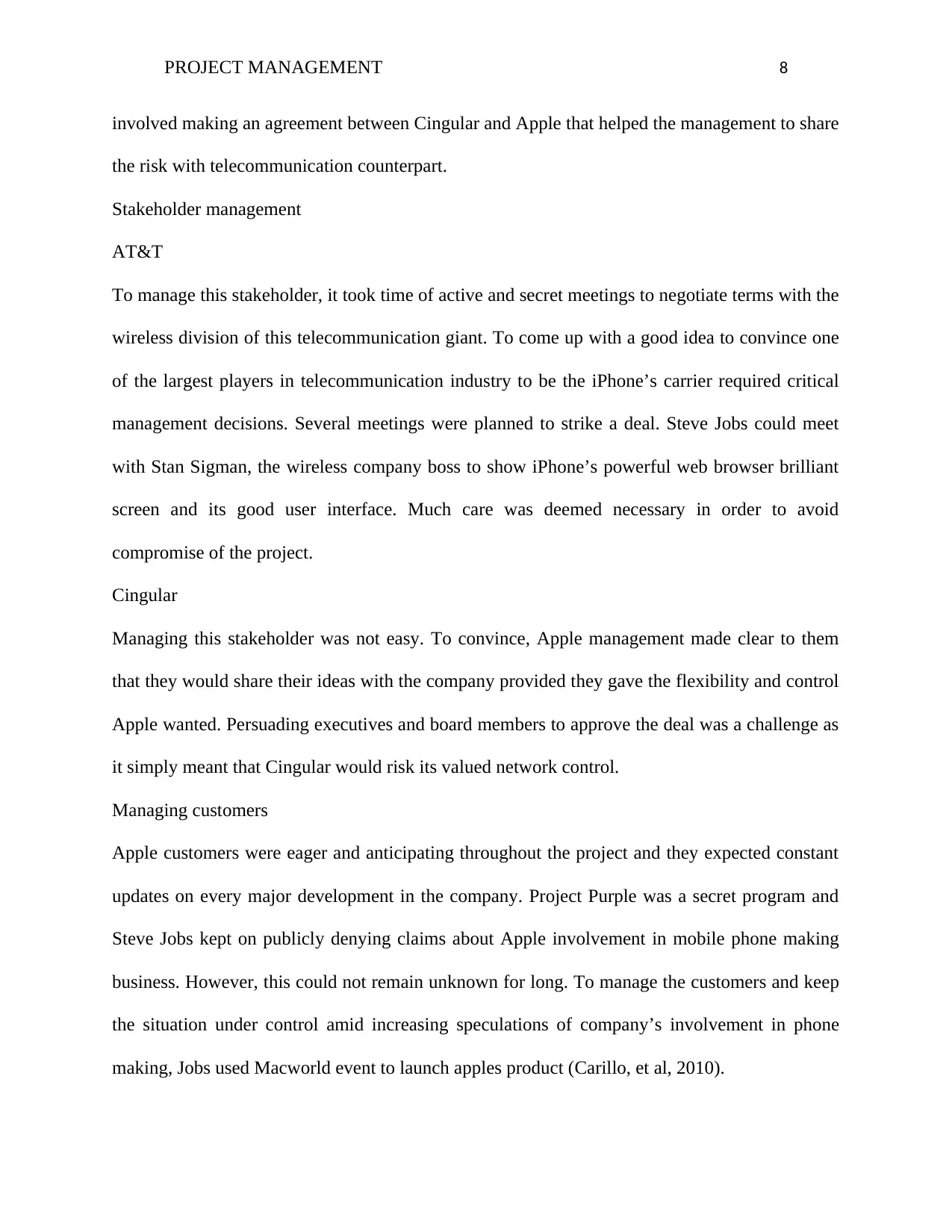
PROJECT MANAGEMENT 8
involved making an agreement between Cingular and Apple that helped the management to share
the risk with telecommunication counterpart.
Stakeholder management
AT&T
To manage this stakeholder, it took time of active and secret meetings to negotiate terms with the
wireless division of this telecommunication giant. To come up with a good idea to convince one
of the largest players in telecommunication industry to be the iPhone’s carrier required critical
management decisions. Several meetings were planned to strike a deal. Steve Jobs could meet
with Stan Sigman, the wireless company boss to show iPhone’s powerful web browser brilliant
screen and its good user interface. Much care was deemed necessary in order to avoid
compromise of the project.
Cingular
Managing this stakeholder was not easy. To convince, Apple management made clear to them
that they would share their ideas with the company provided they gave the flexibility and control
Apple wanted. Persuading executives and board members to approve the deal was a challenge as
it simply meant that Cingular would risk its valued network control.
Managing customers
Apple customers were eager and anticipating throughout the project and they expected constant
updates on every major development in the company. Project Purple was a secret program and
Steve Jobs kept on publicly denying claims about Apple involvement in mobile phone making
business. However, this could not remain unknown for long. To manage the customers and keep
the situation under control amid increasing speculations of company’s involvement in phone
making, Jobs used Macworld event to launch apples product (Carillo, et al, 2010).
involved making an agreement between Cingular and Apple that helped the management to share
the risk with telecommunication counterpart.
Stakeholder management
AT&T
To manage this stakeholder, it took time of active and secret meetings to negotiate terms with the
wireless division of this telecommunication giant. To come up with a good idea to convince one
of the largest players in telecommunication industry to be the iPhone’s carrier required critical
management decisions. Several meetings were planned to strike a deal. Steve Jobs could meet
with Stan Sigman, the wireless company boss to show iPhone’s powerful web browser brilliant
screen and its good user interface. Much care was deemed necessary in order to avoid
compromise of the project.
Cingular
Managing this stakeholder was not easy. To convince, Apple management made clear to them
that they would share their ideas with the company provided they gave the flexibility and control
Apple wanted. Persuading executives and board members to approve the deal was a challenge as
it simply meant that Cingular would risk its valued network control.
Managing customers
Apple customers were eager and anticipating throughout the project and they expected constant
updates on every major development in the company. Project Purple was a secret program and
Steve Jobs kept on publicly denying claims about Apple involvement in mobile phone making
business. However, this could not remain unknown for long. To manage the customers and keep
the situation under control amid increasing speculations of company’s involvement in phone
making, Jobs used Macworld event to launch apples product (Carillo, et al, 2010).
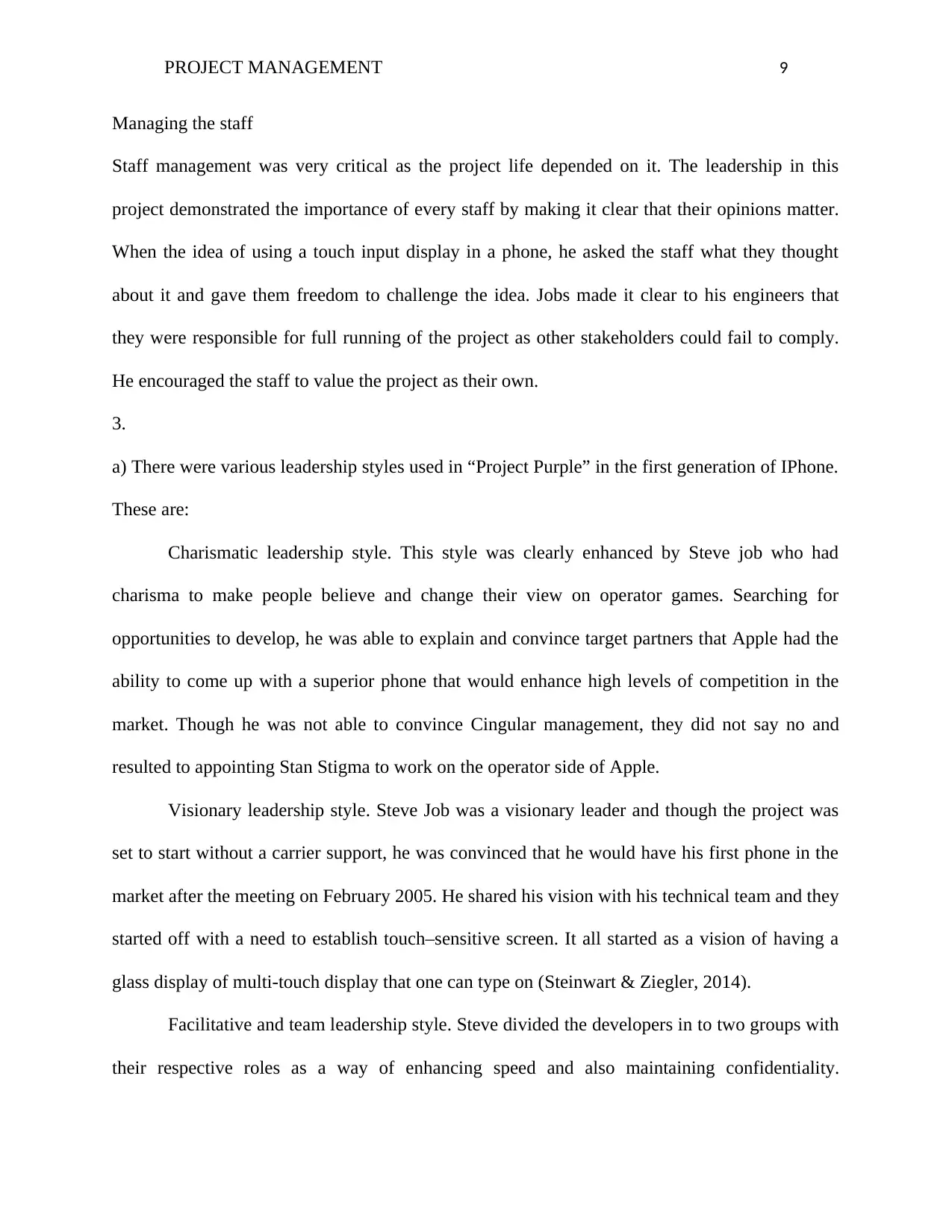
PROJECT MANAGEMENT 9
Managing the staff
Staff management was very critical as the project life depended on it. The leadership in this
project demonstrated the importance of every staff by making it clear that their opinions matter.
When the idea of using a touch input display in a phone, he asked the staff what they thought
about it and gave them freedom to challenge the idea. Jobs made it clear to his engineers that
they were responsible for full running of the project as other stakeholders could fail to comply.
He encouraged the staff to value the project as their own.
3.
a) There were various leadership styles used in “Project Purple” in the first generation of IPhone.
These are:
Charismatic leadership style. This style was clearly enhanced by Steve job who had
charisma to make people believe and change their view on operator games. Searching for
opportunities to develop, he was able to explain and convince target partners that Apple had the
ability to come up with a superior phone that would enhance high levels of competition in the
market. Though he was not able to convince Cingular management, they did not say no and
resulted to appointing Stan Stigma to work on the operator side of Apple.
Visionary leadership style. Steve Job was a visionary leader and though the project was
set to start without a carrier support, he was convinced that he would have his first phone in the
market after the meeting on February 2005. He shared his vision with his technical team and they
started off with a need to establish touch–sensitive screen. It all started as a vision of having a
glass display of multi-touch display that one can type on (Steinwart & Ziegler, 2014).
Facilitative and team leadership style. Steve divided the developers in to two groups with
their respective roles as a way of enhancing speed and also maintaining confidentiality.
Managing the staff
Staff management was very critical as the project life depended on it. The leadership in this
project demonstrated the importance of every staff by making it clear that their opinions matter.
When the idea of using a touch input display in a phone, he asked the staff what they thought
about it and gave them freedom to challenge the idea. Jobs made it clear to his engineers that
they were responsible for full running of the project as other stakeholders could fail to comply.
He encouraged the staff to value the project as their own.
3.
a) There were various leadership styles used in “Project Purple” in the first generation of IPhone.
These are:
Charismatic leadership style. This style was clearly enhanced by Steve job who had
charisma to make people believe and change their view on operator games. Searching for
opportunities to develop, he was able to explain and convince target partners that Apple had the
ability to come up with a superior phone that would enhance high levels of competition in the
market. Though he was not able to convince Cingular management, they did not say no and
resulted to appointing Stan Stigma to work on the operator side of Apple.
Visionary leadership style. Steve Job was a visionary leader and though the project was
set to start without a carrier support, he was convinced that he would have his first phone in the
market after the meeting on February 2005. He shared his vision with his technical team and they
started off with a need to establish touch–sensitive screen. It all started as a vision of having a
glass display of multi-touch display that one can type on (Steinwart & Ziegler, 2014).
Facilitative and team leadership style. Steve divided the developers in to two groups with
their respective roles as a way of enhancing speed and also maintaining confidentiality.
⊘ This is a preview!⊘
Do you want full access?
Subscribe today to unlock all pages.

Trusted by 1+ million students worldwide
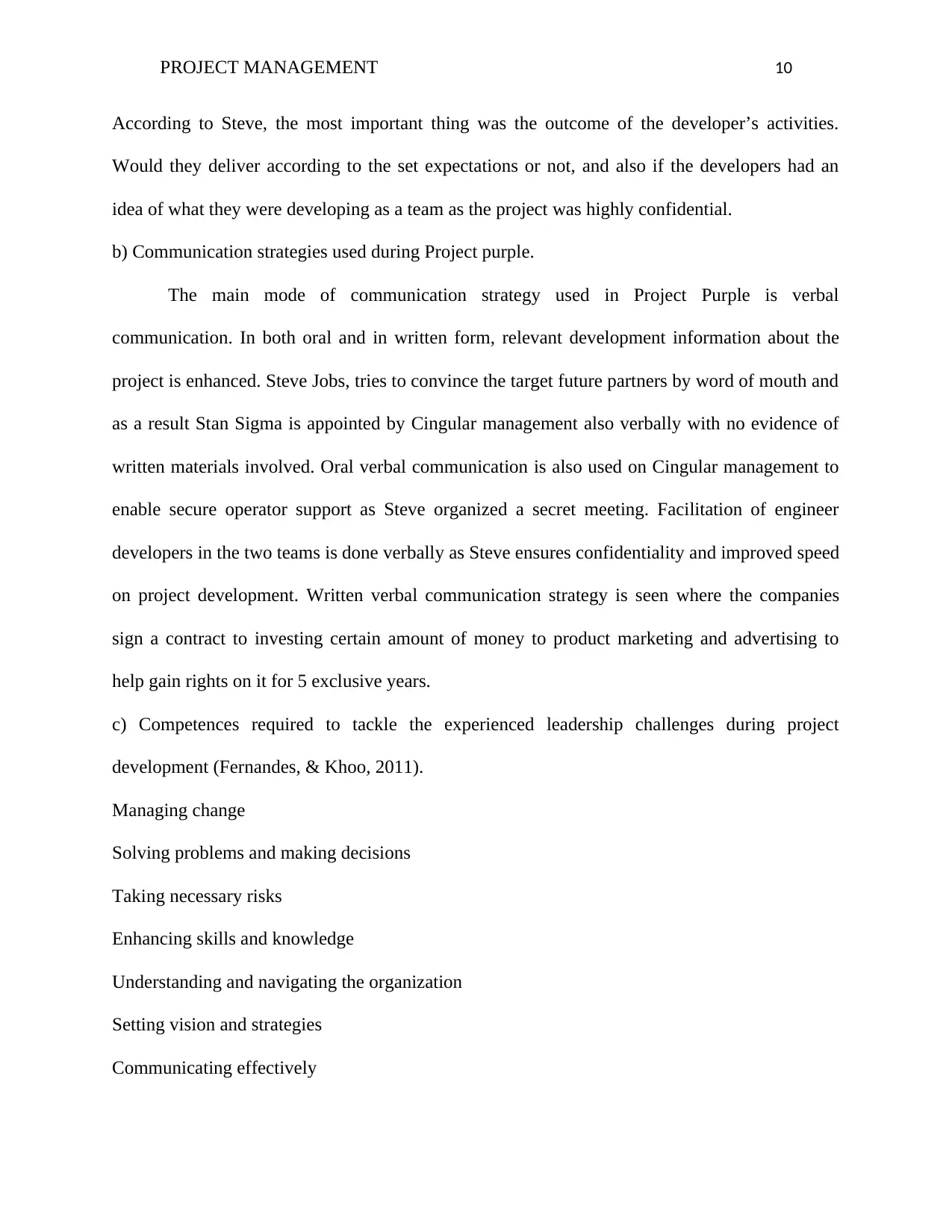
PROJECT MANAGEMENT 10
According to Steve, the most important thing was the outcome of the developer’s activities.
Would they deliver according to the set expectations or not, and also if the developers had an
idea of what they were developing as a team as the project was highly confidential.
b) Communication strategies used during Project purple.
The main mode of communication strategy used in Project Purple is verbal
communication. In both oral and in written form, relevant development information about the
project is enhanced. Steve Jobs, tries to convince the target future partners by word of mouth and
as a result Stan Sigma is appointed by Cingular management also verbally with no evidence of
written materials involved. Oral verbal communication is also used on Cingular management to
enable secure operator support as Steve organized a secret meeting. Facilitation of engineer
developers in the two teams is done verbally as Steve ensures confidentiality and improved speed
on project development. Written verbal communication strategy is seen where the companies
sign a contract to investing certain amount of money to product marketing and advertising to
help gain rights on it for 5 exclusive years.
c) Competences required to tackle the experienced leadership challenges during project
development (Fernandes, & Khoo, 2011).
Managing change
Solving problems and making decisions
Taking necessary risks
Enhancing skills and knowledge
Understanding and navigating the organization
Setting vision and strategies
Communicating effectively
According to Steve, the most important thing was the outcome of the developer’s activities.
Would they deliver according to the set expectations or not, and also if the developers had an
idea of what they were developing as a team as the project was highly confidential.
b) Communication strategies used during Project purple.
The main mode of communication strategy used in Project Purple is verbal
communication. In both oral and in written form, relevant development information about the
project is enhanced. Steve Jobs, tries to convince the target future partners by word of mouth and
as a result Stan Sigma is appointed by Cingular management also verbally with no evidence of
written materials involved. Oral verbal communication is also used on Cingular management to
enable secure operator support as Steve organized a secret meeting. Facilitation of engineer
developers in the two teams is done verbally as Steve ensures confidentiality and improved speed
on project development. Written verbal communication strategy is seen where the companies
sign a contract to investing certain amount of money to product marketing and advertising to
help gain rights on it for 5 exclusive years.
c) Competences required to tackle the experienced leadership challenges during project
development (Fernandes, & Khoo, 2011).
Managing change
Solving problems and making decisions
Taking necessary risks
Enhancing skills and knowledge
Understanding and navigating the organization
Setting vision and strategies
Communicating effectively
Paraphrase This Document
Need a fresh take? Get an instant paraphrase of this document with our AI Paraphraser
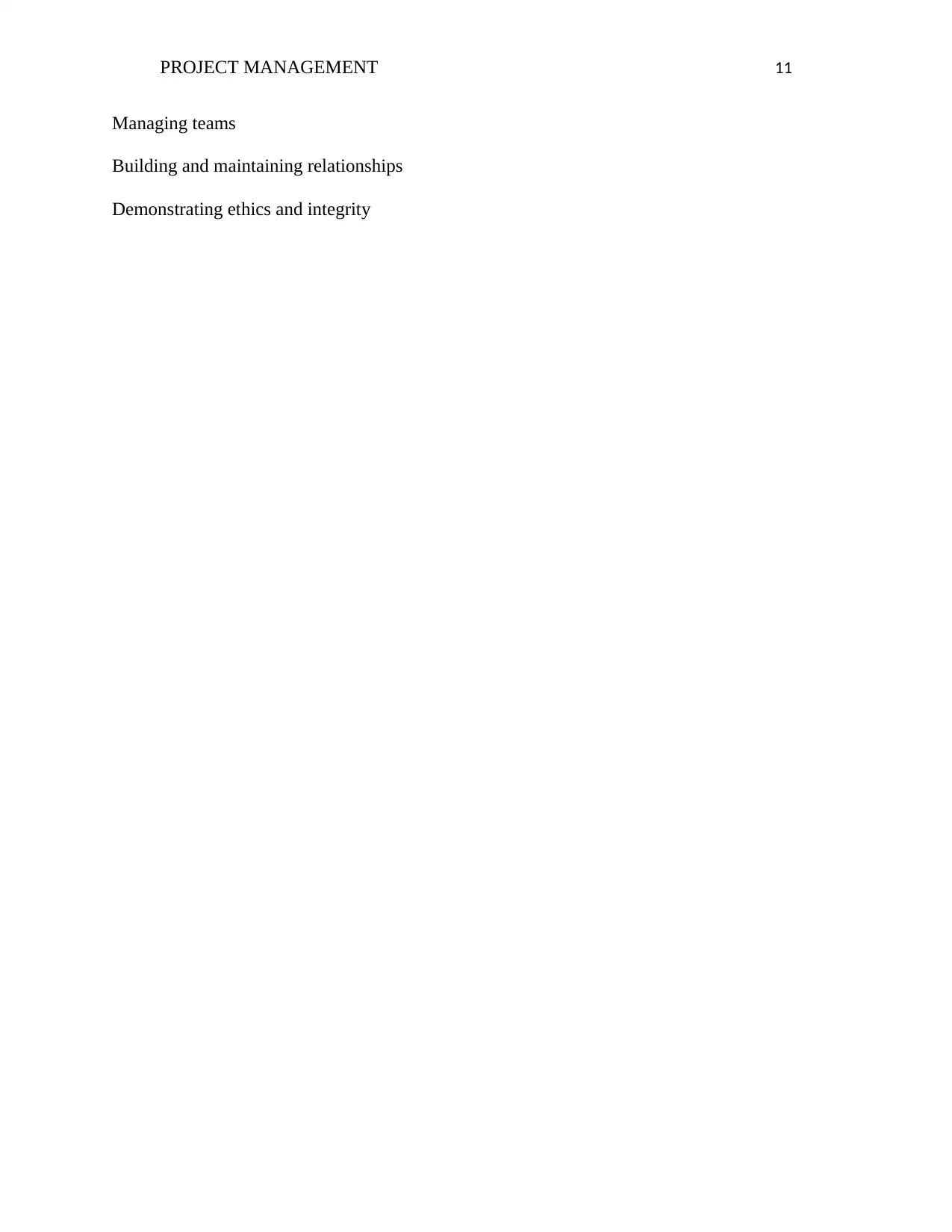
PROJECT MANAGEMENT 11
Managing teams
Building and maintaining relationships
Demonstrating ethics and integrity
Managing teams
Building and maintaining relationships
Demonstrating ethics and integrity
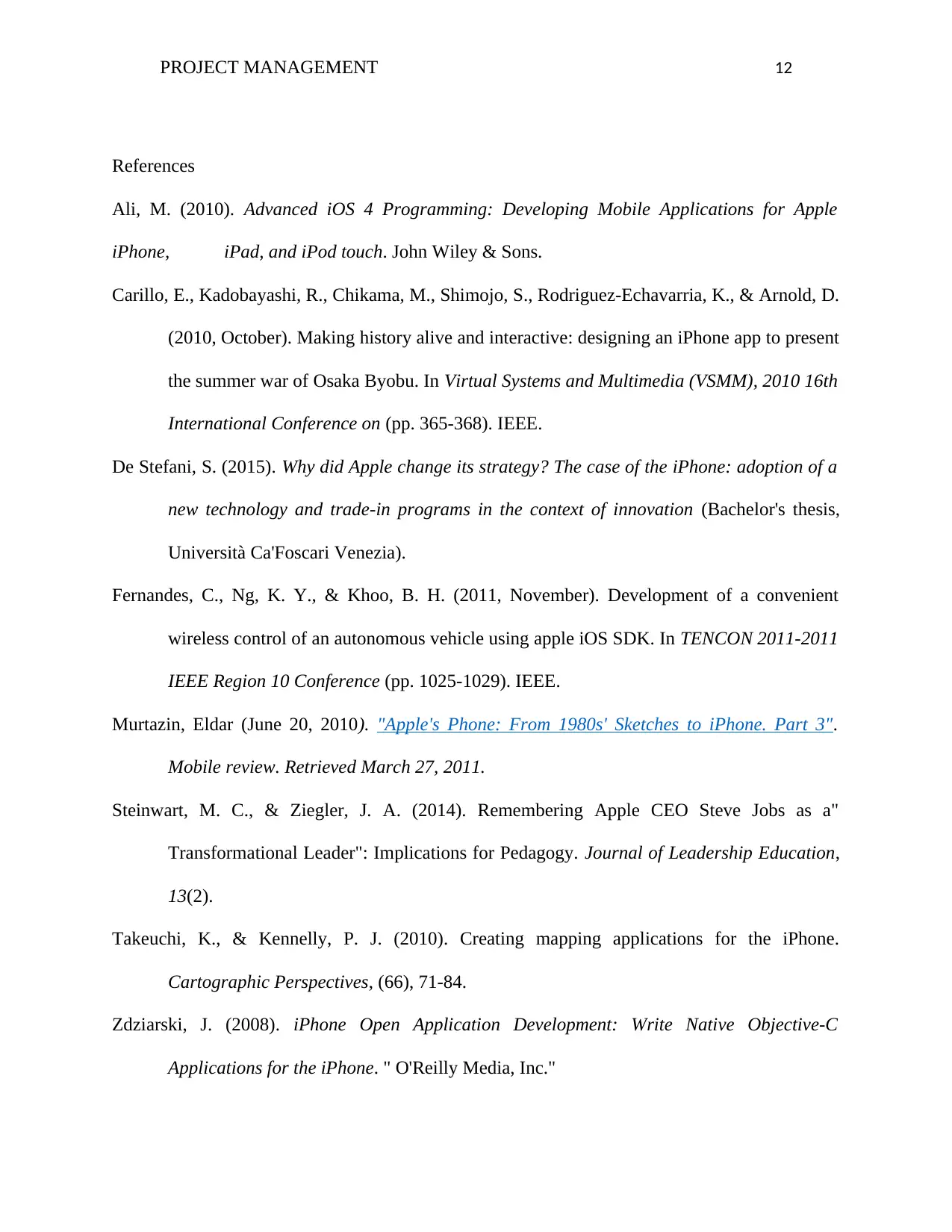
PROJECT MANAGEMENT 12
References
Ali, M. (2010). Advanced iOS 4 Programming: Developing Mobile Applications for Apple
iPhone, iPad, and iPod touch. John Wiley & Sons.
Carillo, E., Kadobayashi, R., Chikama, M., Shimojo, S., Rodriguez-Echavarria, K., & Arnold, D.
(2010, October). Making history alive and interactive: designing an iPhone app to present
the summer war of Osaka Byobu. In Virtual Systems and Multimedia (VSMM), 2010 16th
International Conference on (pp. 365-368). IEEE.
De Stefani, S. (2015). Why did Apple change its strategy? The case of the iPhone: adoption of a
new technology and trade-in programs in the context of innovation (Bachelor's thesis,
Università Ca'Foscari Venezia).
Fernandes, C., Ng, K. Y., & Khoo, B. H. (2011, November). Development of a convenient
wireless control of an autonomous vehicle using apple iOS SDK. In TENCON 2011-2011
IEEE Region 10 Conference (pp. 1025-1029). IEEE.
Murtazin, Eldar (June 20, 2010). "Apple's Phone: From 1980s' Sketches to iPhone. Part 3".
Mobile review. Retrieved March 27, 2011.
Steinwart, M. C., & Ziegler, J. A. (2014). Remembering Apple CEO Steve Jobs as a"
Transformational Leader": Implications for Pedagogy. Journal of Leadership Education,
13(2).
Takeuchi, K., & Kennelly, P. J. (2010). Creating mapping applications for the iPhone.
Cartographic Perspectives, (66), 71-84.
Zdziarski, J. (2008). iPhone Open Application Development: Write Native Objective-C
Applications for the iPhone. " O'Reilly Media, Inc."
References
Ali, M. (2010). Advanced iOS 4 Programming: Developing Mobile Applications for Apple
iPhone, iPad, and iPod touch. John Wiley & Sons.
Carillo, E., Kadobayashi, R., Chikama, M., Shimojo, S., Rodriguez-Echavarria, K., & Arnold, D.
(2010, October). Making history alive and interactive: designing an iPhone app to present
the summer war of Osaka Byobu. In Virtual Systems and Multimedia (VSMM), 2010 16th
International Conference on (pp. 365-368). IEEE.
De Stefani, S. (2015). Why did Apple change its strategy? The case of the iPhone: adoption of a
new technology and trade-in programs in the context of innovation (Bachelor's thesis,
Università Ca'Foscari Venezia).
Fernandes, C., Ng, K. Y., & Khoo, B. H. (2011, November). Development of a convenient
wireless control of an autonomous vehicle using apple iOS SDK. In TENCON 2011-2011
IEEE Region 10 Conference (pp. 1025-1029). IEEE.
Murtazin, Eldar (June 20, 2010). "Apple's Phone: From 1980s' Sketches to iPhone. Part 3".
Mobile review. Retrieved March 27, 2011.
Steinwart, M. C., & Ziegler, J. A. (2014). Remembering Apple CEO Steve Jobs as a"
Transformational Leader": Implications for Pedagogy. Journal of Leadership Education,
13(2).
Takeuchi, K., & Kennelly, P. J. (2010). Creating mapping applications for the iPhone.
Cartographic Perspectives, (66), 71-84.
Zdziarski, J. (2008). iPhone Open Application Development: Write Native Objective-C
Applications for the iPhone. " O'Reilly Media, Inc."
⊘ This is a preview!⊘
Do you want full access?
Subscribe today to unlock all pages.

Trusted by 1+ million students worldwide
1 out of 13
Your All-in-One AI-Powered Toolkit for Academic Success.
+13062052269
info@desklib.com
Available 24*7 on WhatsApp / Email
![[object Object]](/_next/static/media/star-bottom.7253800d.svg)
Unlock your academic potential
Copyright © 2020–2025 A2Z Services. All Rights Reserved. Developed and managed by ZUCOL.